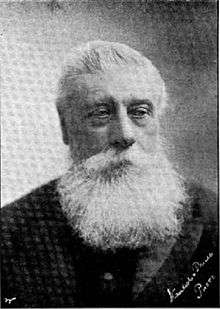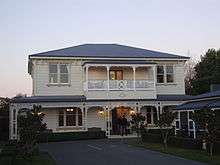Henry Richard Webb
Henry Richard Webb JP FRMS (1829 – 11 February 1901) was a New Zealand businessman and politician. He represented Lyttelton in Parliament for 2½ years and was a supporter of education in his later years. Born in Australia, he came to Canterbury in 1868.
Henry Webb | |
|---|---|
 Henry Richard Webb | |
| Canterbury Provincial Council | |
| In office 13 September 1869 – 1875 | |
| Preceded by | Hugh Murray-Aynsley |
| Member of the New Zealand Parliament for Lyttelton | |
| In office 1873 – 1875 | |
| Majority | 7 (2.95%) |
| Personal details | |
| Born | 1829 Sydney, Australia |
| Died | 11 February 1901 (aged 71–72) Merivale, Christchurch, New Zealand |
| Resting place | Papanui, Christchurch, New Zealand |
| Nationality | |
| Children | Seven sons Two daughters |
Early life
Australia
Webb was born in Sydney in 1829. His parents had arrived there on the ship Eliza in the previous year. He was educated at Sydney College. From an early age, he worked in the office of a business. Later on, he headed the merchant firm of Messrs Ferguson, Webb and Co. In 1851, he visited Auckland.[1][2]
He was married to Ann Vaile by special licence on 27 October 1853, at St. Paul's Church, Auckland, New Zealand by the Rev. T. F. Lloyd, M.A. She was the second daughter of the architect George Vaile.[3] She died on 21 December 1854 at 6 Victoria Terrace, Millers Point, New South Wales.
Webb was two years younger than John Thomas Peacock, who attended the same Sydney college. His second marriage was to one of Peacock's sisters Augusta Ann Peacock. He married her on 15 October 1857 at the Centenary Chapel, York Street, Sydney and emigrated to New Zealand in 1868.[2][4]
New Zealand
For some years prior to 1877, when the Lyttelton Harbour Board was formed, Webb was in charge of Peacock's Wharf in Lyttelton, so named after his brother in law. In 1880, he was appointed as manager to the Permanent Investment Association of Canterbury, a role which he held for ten years.[1][2] He was a director of the Mutual Life Association of Australasia.[5]
Political career
A by-election was held on 13 September 1869 for the Lyttelton seat of the Provincial Council following the resignation of Hugh Murray-Aynsley. Webb, although being new in the colony, was nominated. Since there were no other candidates, he was declared elected.[6] He was represented on the Provincial Council until 1875, and was secretary during 1873–1875.[4]
| New Zealand Parliament | ||||
| Years | Term | Electorate | Party | |
| 1873–1875 | 5th | Lyttelton | Independent | |
In April 1873, his brother in law, Peacock, was appointed to the Legislative Council and thus had to resign his seat for the Lyttelton electorate in Parliament. A by-election was set for 19 May 1873, which Webb and Murray-Aynsley contested. Webb and Murray-Aynsley received 122 and 115 votes respectively, a majority of seven for Webb, who was thus declared elected.[7]
At the 28 December 1875 general election, the Lyttelton electorate was again contested by Webb and Murray-Aynsley. This time, Murray-Aynsley was the successful person, with a majority of 32 votes.[8]
Later life
Interests and memberships

In Sydney, he had been a member of the Horticultural and Agricultural Society of New South Wales. He continued this interest in Canterbury, studied botany, and was a member of the Christchurch Horticultural Society, including its chairman.[1]
He was a member of the Royal Microscopical Society of London, and was elected a Fellow in 1880 (hence his honorific suffix FRMS).[2]
Webb was very interested in education. He was on several education governance bodies. He was chairman of the Lyttelton School committee. He was one of the school commissioners for Canterbury for eighteen years. He was a member of the North Canterbury Board of Education for several years, including chairman. He was a member of the Canterbury College (what is these days the University of Canterbury) Board of Governors since its establishment in 1873, and was the chairman from 1894 up to the time of his death.[1][2]
He was a leading member of the Anglican Church and was on various committees, both on a local and national level.[1][2]
In the 1880s, he built a large residence 'Te Wepu' on Papanui Road, with an entrance off a side street that was named Webb Street.[4] The house is used as a hotel and apartments these days and has been renamed Merivale Manor.[9] The building is registered as Category II by Heritage New Zealand.[10]
Family
Through his wife, a née Peacock, Webb had three brothers in law as fellow Members of Parliament.[2][11]
John Evans Brown (1822–1907), known as "Yankee" Brown, married Webb's wife's sister Theresa Australia. Brown was from Pennsylvania and owned land north of the Waimakariri River inland from Kaiapoi, which he gave the Cherokee name of ‘Swannanoa’. Brown represented the Ashley electorate from 1871 to 1879, and the St Albans electorate from 1881 to 1884.[11]
Francis James Garrick (1833–1890) was also from Sydney and attended Sydney College. He married Webb's wife's oldest sister, Elizabeth. He came to New Zealand in 1864, and succeeded Brown in the St Albans electorate from 1884-87.[11]
And as outlined above, Webb succeeded his wife's brother John Thomas in the Lyttelton electorate in 1873 after his resignation due to his appointment to the Legislative Council.
Webb's second daughter, Malvina Mary, married Robert McDougall (1860–1942), who was the benefactor of the Robert McDougall Art Gallery that opened in 1932. The McDougall residence Fitzroy was later gifted to Nurse Maud and is still in use as a hospital, located between Mansfield and McDougall Avenues.[4][12]
Death and commemoration
Webb died on 11 February 1901 at his residence in Merivale. He had been suffering from gastritis. He was survived by his wife, seven sons and two daughters. The bells of the Christ Church Cathedral were rung in his honour, and many flags were flown at half mast. He was buried at Papanui cemetery.[1]
Webb Street in Merivale carries his name.[4] McDougall Avenue commemorates his daughter Malvina Mary's husband's name.[12]
References
- "OBITUARY" (7022). The Star. 12 February 1901. p. 3. Retrieved 15 April 2010.
- "Mr. Henry Richard Webb". The Cyclopedia of New Zealand : Canterbury Provincial District. Christchurch: The Cyclopedia Company Limited. 1903. Retrieved 17 April 2010.
- The Sydney Morning Herald. 9 December 1853. p. 5. Missing or empty
|title=(help) - Harper, Margaret. "Christchurch Street Names W-Z" (PDF). Christchurch City Libraries. p. 25. Retrieved 18 June 2012.
- "Commission Agents, &c". XLIII (3659). Timaru Herald. 24 June 1886. Retrieved 17 April 2010.
- "LYTTELTON ELECTION" (415). The Star. 13 September 1869. p. 2. Retrieved 17 April 2010.
- "LYTTELTON ELECTION" (1634). The Star. 20 May 1873. p. 3. Retrieved 15 April 2010.
- "LYTTELTON POLLING" (2424). Lyttelton: The Star. 29 December 1875. p. 2. Retrieved 18 April 2010.
- "Merivale Manor". Merivale Manor. Archived from the original on 25 May 2010. Retrieved 17 April 2010.
- "Te Wepu". Register of Historic Places. Heritage New Zealand. Retrieved 18 June 2012.
- Greenaway, Richard L. N. (June 2007). "Barbadoes Street Cemetery Tour" (PDF). Christchurch: Christchurch City Council. p. 10. Retrieved 16 April 2010.
- "Robert Ewing McDougall, 1860-1942". Christchurch City Libraries. Retrieved 16 April 2010.
| New Zealand Parliament | ||
|---|---|---|
| Preceded by John Thomas Peacock |
Member of Parliament for Lyttelton 1873–1875 |
Succeeded by Hugh Murray-Aynsley |
| Academic offices | ||
| Preceded by Frederick de Carteret Malet |
Chairman of the Board of Governors of Canterbury College 1894–1901 |
Succeeded by Thomas S. Weston |